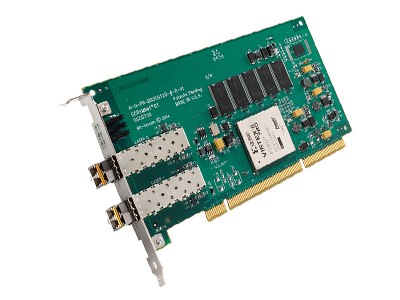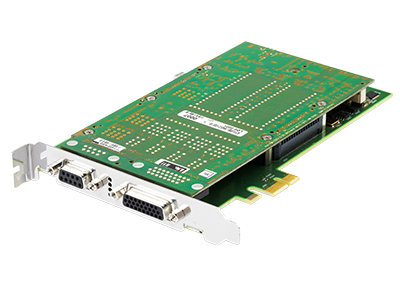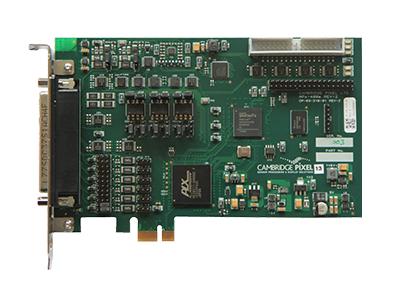PCI/PCIe
A versatile expansion form factor for use in industrial PCs and servers.
Unitronix supply General Standards Analogue IO, NAI GP IO, Sensory Video interfaces, AIM Avionics databus, GET NTDS and Brandywine timing cards on this form factor.

NETWORKING
SCRAMNet Network products have provided an model data communications solution for simulation, virtual reality and other real-time applications with critical performance requirements for more than two decades. Based upon a replicated shared-memory concept, SCRAMNet Network products are optimised for the high-speed, ultra-low-latency transfer of data, among many computing platforms that are all solving portions of the same real-time problem. The simplicity and speed of SCRAMNET Network products are ideal for applications requiring a lot of synchronisation and control.
SCRAMNet GT200 provides the same accuracy as previous generations of SCRAMNet products and additionally has the memory and bandwidth to handle your most demanding data throughput requirements. With SCRAMNet GT200 control and data networks combined into a single, high-speed, low-latency data link with industry leading features; 128 MB of shared memory, data transfers at 2.5 Gbit per second, and data throughputs exceeding 210 MB per second. It is able to simultaneously handle network control functions and network data streams simultaneously, thereby eliminating the need for multiple networks in the same real-time system.
Unitronix offer a range of IO cards, that cover anologue, digital, serial, single and muli-function.
Example: NAI’s 76C2 is a PCI Multifunction I/O and Communication Board with three independent function module slots that can be configured with a variety of I/O and communication functions. Additional enhancements include FIFO data buffering for select modules. Using multiple DSPs, the enhanced motherboard enables higher processing power and dedicated pre-processing control for each module.
By eliminating the need for multiple, specialised, single-function boards, this unique design increases packaging density, saves enclosure slots and reduces power consumption. The 76C2, a low-power/high-performance board, is ideally suited for rugged defence, commercial aerospace, and industrial applications.

DIGITISERS
The PCI Express form factor is suitable for mounting in PCs with PCIe connectors and interfaces. Physically, the XMC module reviewed in the previous page is mounted on a PCI Express carrier board with x8 PCIe motherboard connectors.
Other connectors on this board provide additional interfaces as described below. The unique design of the PCIe carrier includes an integrated fan that keeps the module cool even in demanding situations while requiring a single PCIe slot.
The PCIe board includes an industry standard interface fully compliant with PCI Express Gen. 1, 2 & 3 bus specifications. Gen. 3 provides 8 GB/sec peak transfer rate. The PCIe interface includes multiple DMA controllers for efficient transfers to and from the module.
Example: APE1553-x-DS Single or Dual Stream MIL-STD-1553A/B Test and Simulation Module for PCI Express with the option for MILScope™ capability
A unique feature of AIM’s APE1553-x-DS modules is the option for the MILScope™ capability. Models APE1553-1-DS/APE1553-2-DS integrate an onboard Analogue to Digital Converter (ADC) which samples, measures and stores the MIL-STD-1553 waveform. Automatic waveform validation is performed by the users Application Software or in conjunction with AIM’s PBA.pro Databus Test and Analysis Software and Test Scripts.
The HPx series of radar interface cards from Cambridge Pixel includes the HPx-400e, HPx-250, HPx-200 and HPx-346 cards . These cards can be provided with various software packages, ranging from a low-level board support library, up to the SPx Development library and full-featured server or client display applications.
Example: Primary Radar Acquisition PCIe
The HPx-400e is a high-performance PCI express dual-stream radar acquisition card. The card is capable of capturing and processing analogue and digital primary radar video from up to two radars. The card may be used with a board support library for basic radar signal acquisition, or with Cambridge Pixel’s SPx software for complex processing, tracking or display requirements.
It also supports a number of multi-channel input modes, including dual redundancy and fully independent dual-stream capture. This flexibility allows the number of radar input cards to be reduced while retaining system capability.

TIMING
A variety of options are available for our timing cards; the list of more common options are: extended temperature range, eight external event inputs, TCXO and OCXO time bases and multiple output codes such as IRIG B and 1PPS.
Example: The PCI-Express time code reference timing card with standard options such as IRIG B and optional GPS receiver provides an extermely accurate time source to the PCI-Express bus. This syncclock acts as a time code reader and/or time code generator that is synchronised to an external source of time such as IRIG B, IRIG A, IRIG G, NASA36 or Have Quick Time Code. An optional on-board GPS receiver allows another source of synchronisation.
The PCI Express card uses its time source to generate time from an internal disciplined oscillator, that can be accessed across the PCI-Express bus through a set of zero latency time registers. Time synchronisation can be achieved by simply reading the time registers, using this PCI card to generate periodic interrupts, or the PCI-Express can latch the time of an external event.

NTDS
GET Engineering’s family of PCI NTDS Interface Adapters provide the user with a full‑Duplex NTDSinterface between an NTDS Computer or Peripheral equipment channel and PCI bus systems.
The interface adapters for NTDS Parallel and Serial systems are software configurable to operate in all NTDS environments. Our proprietary Common Driver Design API allows the programmer to write interchangeable application software which can be used in either parallel or serial systems.
Embedded computing is not easy, the nature of customers applications means that systems they are developing are often unique.
In this challenging engineering environment UNITRONIX provides a high level of in depth technical support to our customers both pre-sales and post-sales helping de-risk our customers projects.
Let us know what you are working on and we’ll get an engineer to give you a call and have a chat.





